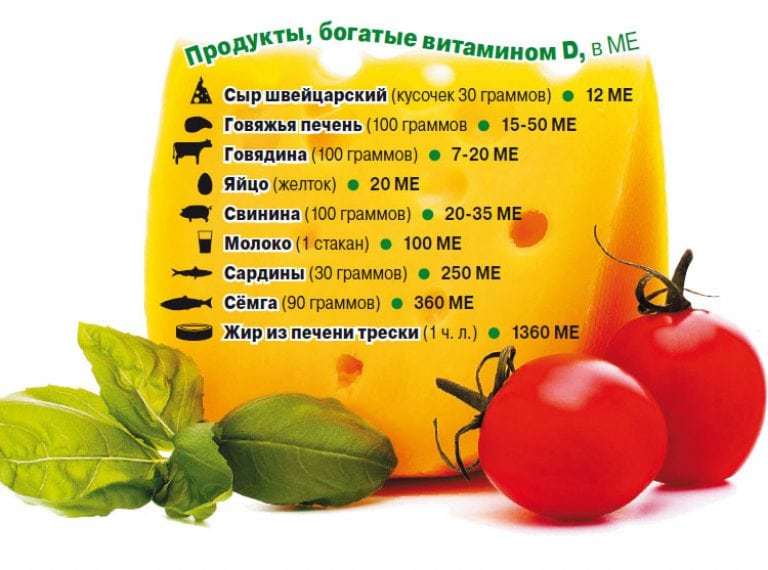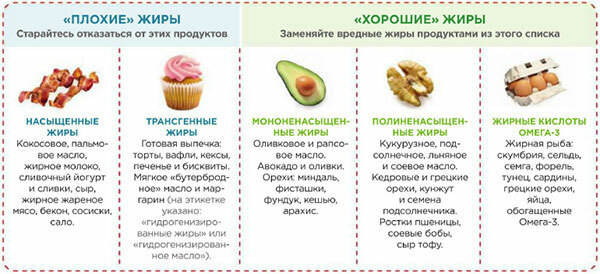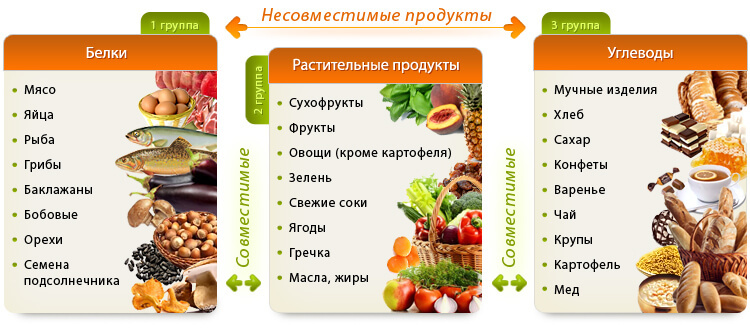Vitamin D (calciferol): its functions, norm, foods in the table
Vitamin D or D (calciferol) is a group of biologically active substances. Cholecalciferol is synthesized by ultraviolet rays in the skin and enters the human body with food.
Content
- What can a vitamin D deficiency lead to?
- Vitamin D deficiency symptoms
- Consequences of untimely treatment
- Causes of vitamin D deficiency in adults
- Causes of vitamin deficiency in pregnant women
- Vitamin D deficiency in children
- Symptoms
- Causes of hypo- and avitaminosis in children
- Deficiency Diagnostic Analysis
- Treatment
- Foods containing vitamin D in the table
What can a vitamin D deficiency lead to?
Vitamin D deficiency is a serious problem with many consequences. Depending on the age of the person, the manifestations will be different, but the mechanism is the same. With a lack of vitamin D, the following occurs:
- the synthesis of proteins of the adenylate cyclase, guanylate cyclase and inositol phosphate systems is disrupted: intracellular Ca-binding protein, calmodulin, calcium-dependent ATP-ase and others;
- the regulation of phosphorus-calcium homeostasis is disturbed.
The consequence of this disorder is a decrease in the activity of calcium-dependent protein kinases, key enzymes many intracellular reactions, as a result, the process of phosphorylation of enzyme proteins, their activity falls. At the same time, phosphorus and calcium ions cannot be absorbed normally, they are washed out of the body. Phosphorus-calcium deficiency leads to disruption of the processes of synthesis and breakdown of glycogen, the formation and use of energy in the form of ATP. Neuromuscular excitement, muscle contraction, transmembrane transport of substances, secretory function of cells, blood clotting are impaired.
The most unpleasant thing happens in the bone tissue, the lack of vitamin D in adults provokes a failure in the transcription process and translation of collagen and some non-collagen proteins, they are mineralized and as a result, the process increases resorption. As a result, the bones gradually loosen up.
Vitamin D does not accumulate in tissues with the exception of adipose tissue. In obesity, adipocytes (fat cells) take the vitamin from the blood and its circulation stops.
Vitamin D deficiency symptoms

The severity of symptoms will depend on the amount and duration of the missing vitamin. Some of the symptoms may correspond to other diseases, so an accurate diagnosis is needed before a diagnosis is made. Each person is individual, therefore, not all manifestations can be observed in full:
- drowsiness;
- lethargy, tiredness and general weakness;
- joint and bone pain;
- sleep disturbance;
- loss of appetite;
- stool disorder (diarrhea);
- a sharp change in mood (nervousness, irritability);
- deterioration of vision;
- sweating of the scalp;
- muscle cramps;
- burning sensation in the mouth;
- immunity falls (a person often has a cold or flu);
- the appearance of caries;
- deterioration of the skin and nails;
- frequent fractures with minor injuries;
- weight loss.
Read also:Food poisoning: causes, symptoms and treatment at home
Consequences of untimely treatment
With an advanced form of vitamin D deficiency, an adult develops:
- osteoporosis (bones are like glass, fragile);
- osteomalacia (bones like plasticine, soft).
Both processes lead to severe deformation of the human skeleton, which is irreversible. In addition to the skeletal system, teeth suffer. Perhaps the manifestation of chronic granulomatous intestinal inflammation (Crohn's disease). Vitamin D deficiency can contribute to the development of the following diseases:
- hypertension;
- stagnant heart failure;
- multiple sclerosis;
- type 2 diabetes;
- rheumatoid arthritis;
- bronchial asthma;
- periodontal disease;
- oncological lesions.
An interesting fact was also established about the relationship between vitamin deficiency and development. depression.
For reference! Vitamin D exists in three main active forms (D2 - ergocalciferol, D3-cholecalciferol, D4 - dehydroergocalciferol). The depressive state is associated with a decrease in the level of cholecalciferol (D3 is formed when the skin is irradiated with ultraviolet light). In the presence of D3, the level of neurochemicals (dopamine, serotonin) increases, which are responsible for a good mood.
Causes of vitamin D deficiency in adults
With age (over 50 years), the work of organs deteriorates, it becomes more difficult for the kidneys to convert a full-fledged vitamin, there is a problem of its assimilation. This may be due to poor organ function and diseases:
- kidney (stones in the kidneys, renal failure, nephroptosis);
- liver (for example: cirrhosis of the liver);
- diseases of the stomach and intestines (nonspecific ulcerative colitis, Crohn's disease, intestinal obstruction etc.);
- cystic fibrosis;
- celiac disease.
The use of antacids (drugs that treat acid-dependent diseases of the gastrointestinal tract) can also affect.
Another of the main reasons for the deficiency of this substance is insufficient insolation. Vitamin D is unique, as it becomes full after exposure to ultraviolet rays, and is initially in a state of "provitamin". Some people are distinguished by very dark and dark skin, which protects from the effects of ultraviolet radiation, the formation of calciferol is inhibited.
Causes of vitamin deficiency in pregnant women
During pregnancy, a woman's body works for two. All nutrients the expectant mother should receive in double the amount throughout pregnancy, because at the beginning, the embryo forms the laying of all vital organs, and by the end of gestation fixing. In the last three months of pregnancy, a woman's phosphorus-calcium metabolism may be disturbed, since all useful substances go to the successful formation of the fetus.
Read also:How to properly take flax seeds to cleanse the body of toxins and lose weight
The woman continues to lose irreplaceable organic microcomponents during breastfeeding. That's why nutrition of a nursing mother should be complete, varied and nutritious.
Doctors advise to eat more dairy products, chicken eggs, beef liver. There is a lot of vitamin D in fatty fish (salmon, salmon, tuna), shrimp and oysters. Therefore, a vegetarian diet can lead the body to depletion and a lack of a microcomponent (although it is contained in plant foods, it is absorbed much worse in this form).
Vitamin D deficiency in children

In children, vitamin D deficiency leads to a serious illness - rickets. The process of absorption of phosphorus and calcium ions in the intestine is disrupted, reabsorption in the kidneys is reduced. As a result, the concentration of ions in the blood decreases, and calcium phosphate is not deposited in the bone tissue. Osteogenesis, dentin formation and tooth development become abnormal. The skeleton of the baby is undergoing deformation, but this is only the visible part of the iceberg of deep and dangerous violations of biochemical and philological processes in the body.
Symptoms
In a baby, in the period from a week to two months, it is observed:
- tearfulness;
- weight loss;
- sleep disturbance;
- slow growth or lack thereof;
- dry skin;
- hair loss in the back of the head;
- soft edges of the large fontanelle.
In the period of 3-6 months:
- deformation of the bone framework;
- muscular hypo- or atony ("frog belly");
- flattening of the occiput with osteophytes (quadrangular head shape);
- delay in psychomotor development.
In the period after two years (late form of rickets):
- O-shaped, X-shaped and saber-shaped shins
- flat pelvis
- in the region of the bone-cartilaginous part of the rib, thickenings ("rosary") appear, in the area of the epiphyses of the tubular bones ("bracelets")
- expressed kyphosis.
Causes of hypo- and avitaminosis in children
The main causes of deficiency lie from the moment the baby is born to 2 years. Little-informed young mothers do not arrange sun baths for their crumbs. Indeed, even in gloomy weather, when the sun is not visible, ultraviolet rays do not stop their action. Therefore, at least 30 minutes of walking a day is necessary for the baby.
Improper nutrition or early feeding does the trick. After a year of a baby's life, his diet should include animal and vegetable fats, carbohydrates and proteins. Dysbacteriosis interferes with absorption processes, vitamin D is not absorbed. Infections reduce the infant's immunity, and hence the ability to absorb microelements and vitamins well. Physical inactivity - a sedentary lifestyle - reduces the ability to assimilate.
Read also:PP diet - follow the right diet for weight loss
Deficiency Diagnostic Analysis
This analysis is not expensive, not complicated, and as accurate as possible. Blood is required from the patient, which is checked on the 25-hydroxyvitamin D test. The only requirement is not to eat four hours before taking body fluid. The normal laboratory test range is 30 to 74 nanograms per milliliter (ng / ml). Doctors record the minimum level at 50 ng / ml. All indicators below 20 can be considered the strongest shortage.
Treatment
Wellness therapy is selected by the attending doctor individually for his patient, taking into account all the characteristics and results of laboratory tests. The remedy for the deficiency is a dose of vitamin D that will not be toxic to the body. The therapist makes an appointment taking into account the compatibility of the drug with other medications (if the patient takes any) and prescribes ascorbic acid, provitamin A, B vitamins. In the presence of organ diseases, prescribes complex treatment.
The patient should adhere to a correct and balanced diet with foods rich in calciferol. Supplements can also be taken with food in the form of capsules with a dosage of 1000-5000 IU.
You should not abuse supplements, preferably, after a month of taking cholecalciferol, do a blood test and make sure there is no overdose.
One of the most enjoyable treatments is walking in the fresh air for 20 to 30 minutes a day. Also, the possibility of using a light box during the winter period and for people working at night is not excluded. Additionally, a medical professional can prescribe a course of UFO therapy.
Foods containing vitamin D in the table
Below is a table listing foods that are high in vitamin D. We also recommend that you read the video below, which also shows a diet with a deficiency of this substance.




